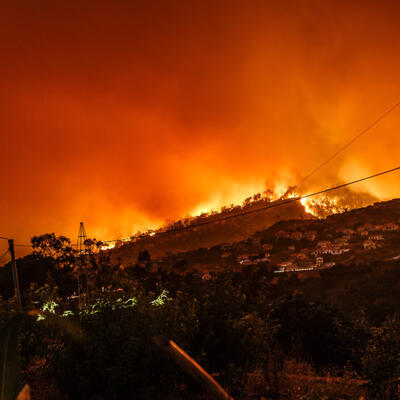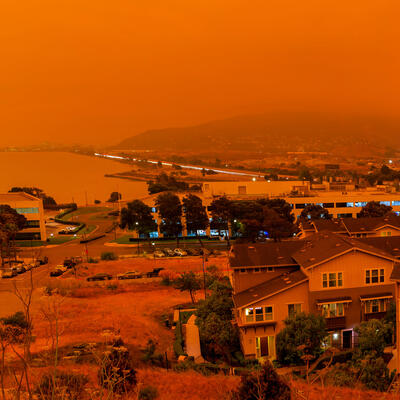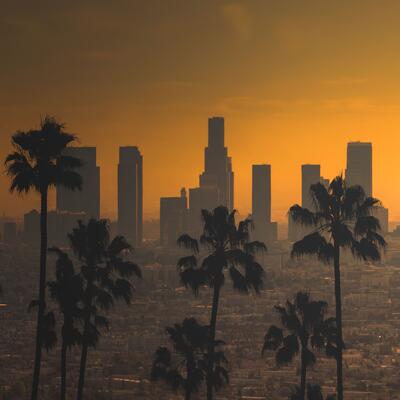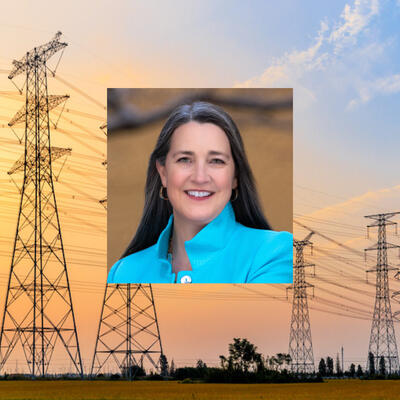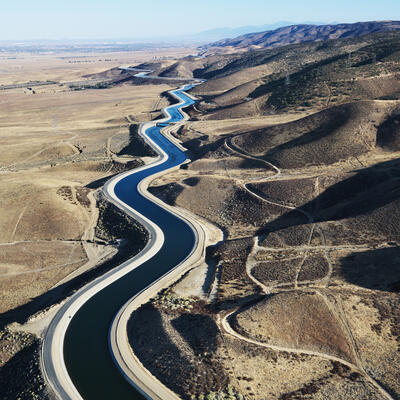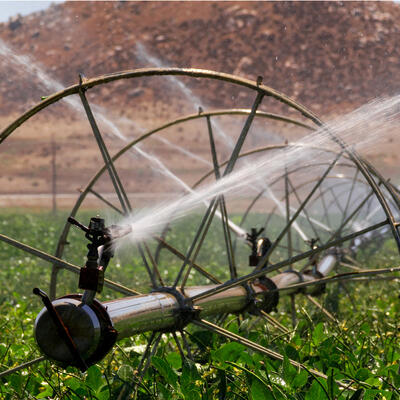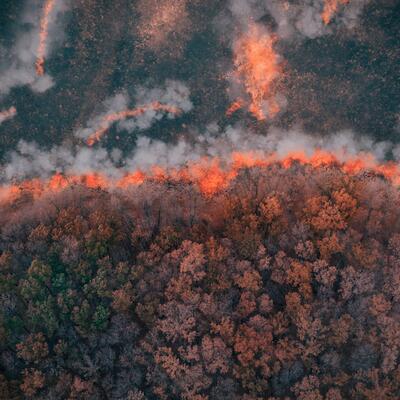
Rekindling Our Relationship With Wildfire
Guests
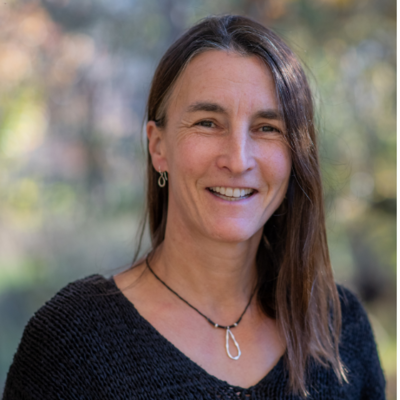
Susan Prichard
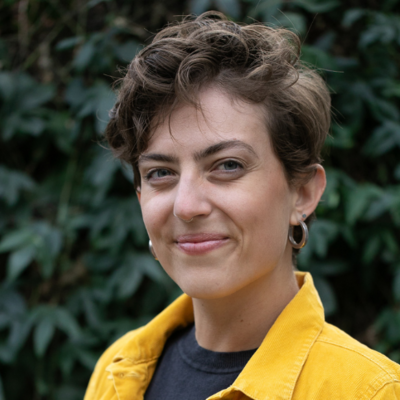
Ana Alanis
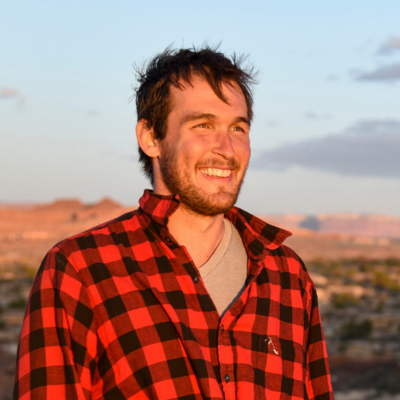
Nick Mott
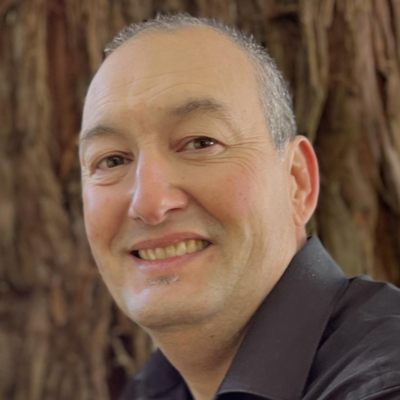
Frank Kanawha Lake
Summary
Summer is just around the corner, and in addition to travel and vacation, that also means peak wildfire season. Recently we’ve seen some of the most destructive wildfires in recorded history. The images on the news of orange skies and opaque haze around cities and homes can seem downright apocalyptic. And whether you live in fire country or not, it’s almost impossible to escape the smoke – which is terrible for our health and our kids’ health.
These fires do have a human toll. Ana Alanis is a climate justice advocate and the founder of Hungry for Climate Action. In 2021, her childhood home in Coffee Creek California was threatened by a nearby wildfire. She remembers visiting the house as evacuation orders started to go out. She didn't realize it would be the last time. “It just felt surreal. Like it felt performative. Like, it was hard to get your head around the fact that you were actually needing to do this.” says Alanis. She and her family escaped the fire unharmed physically. But she says she’s still recovering from losing her childhood home.
“What a better place to live and recreate for a fire ecologist than fire country,” says Susan Prichard, Fire Ecologist at the University of Washington School of Environmental and Forest Sciences. Prichard experienced the largest fire of her career with the 2006 Tripod Complex Fire. That fire affected around 175,000 acres. “I saw this smoke plume that went up about 30,000 feet in the air. It was very dramatic. And what surprised me the most was how unlivable it was to endure a wildfire once that smoke column collapsed and smoked out our valley,” says Prichard.
More and more fire managers are looking to beneficial, or prescribed, fires to help prevent the large catastrophic wildfires. Susan Prichard says prescribed fires, “happen under a prescription window of favorable weather and atmospheric conditions.” This means that while it is still a wildfire, it probably will not escape and probably not smoke out communities.
“When we think about rain sometimes we think about rain as either just a rainfall and necessary for our gardens to grow, or it can turn into a massive flood. Same thing with wind. Oh, it's a windy day, but then we have hurricanes. Why isn't fire allowed to just be fire sometimes, and be beneficial?” says Prichard.
As prices rise in city centers, people are building homes in more fire prone areas. Nick Mott is a multimedia journalist and author of This is Wildfire: How to Protect Yourself, Your Home and Your Community in the Age of Heat. Mott says, “we have a changing climate, meaning more areas of the country are hotter and drier and more prone to burn. So we're really making things a lot worse for ourselves by where we're choosing to build.” Many people think of fire prevention as a service someone else provides, but Nick Mott thinks communities have the ability to protect themselves, “everything from cleaning out your gutters of leaves and pine needles to working on fire resistant gardening practices that can help keep fire from coming up against your house if it comes from far away.”
Wildfires are a natural process – and one that often rejuvenates forests. In fact many species depend on fire for some aspect of their habitat or food. As we’ve been relearning in recent years, fire is actually necessary to maintain a healthy ecosystem.
While prescribed fires may be a new idea to many, Indigenous communities have used fire to manage their environment for thousands of years. Frank Lake, Research Ecologist and Tribal Liaison for the USDA Forest Service, says, “For many tribes, fire’s considered medicine and tribes have always adapted to the effects of climate change.” And now, government officials are turning to indigenous communities for their expertise, “It's been an opportunity for the Forest Service to align their authorities and their policies with that of the tribes, with that of the community,” says Lake.
This episode was supported by the Resources Legacy Fund.
What Can I Do?
Resources From This Episode (3)
Full Transcript
Note: Transcripts are generated using a combination of automated software and human transcribers and may contain errors. Please check the actual audio before quoting it.
Greg Dalton: I’m Greg Dalton.
Ariana Brocious: And I’m Ariana Brocious.
Greg Dalton: And this is Climate One.
[music change]
Greg Dalton: It’s the beginning of summer and that means people around the world are on the look-out for wildfires.
Ariana Brocious: Right, This is one of the most devastating effects of the climate crisis: these intense wildfires that wipe out whole communities, and transform the skies over huge parts of the country. We've seen the harrowing pictures and videos in the news and it can look like the apocalypse. And whether you live in fire country or not, it’s almost impossible to escape the smoke – which is terrible for our health and our kids’ health.
Greg Dalton: Here in the Bay Area, we have inhaled smoke from fires hundreds of miles away, wherever the smoke originates, breathing it is disgusting. And of course, in the actual paths of these fires, people lose homes… and even their lives.
Ariana Brocious: For most of the twentieth century, the messaging was: all fires are bad fires. Let’s put them out. I grew up with Smokey the Bear.
Greg Dalton: Me too.
Ariana Brocious: Smokey has been around for decades, but here is a particularly catchy version of his message from the height of the boy band era…
[Smokey the Bear playback]
Greg Dalton: That’s a lot hipper than the Smokey I remember but…
Ariana Brocious: Only you, Greg, only you, can prevent forest fires. And he’s still around, there’s a billboard of him in my city right now.
Ariana Brocious: And he’s not wrong. We don’t want to start wildfires as the general public – we SHOULD still be careful with matches and sparks. But in the last couple decades the way we understand and manage wildfires has started to change.
Greg Dalton: Right and this is a big and slow shift… Today on the show, we’re going to hear from forestry and public lands experts who are reexamining our relationship with wildfire, and some people whose lives have been transformed by those fires.
[music change]
Greg Dalton: Susan Prichard has lived through several record-setting wildfire seasons in Eastern Washington. She’s a fire ecologist and research scientist at the University of Washington. She researches how fire and climate disruption shapes forest dynamics, and how tools like thinning and purposeful burning can make wildfires and their smoke less severe. Given everything she knows about wildfires, I asked her why she chooses to live where she does.
Susan Prichard: One of the things that I really appreciated about living here is that it's fire country. What a better place to live and recreate for a fire ecologist than fire country. I also was very aware that the Methow people preceded me for a long time. Over 10,000 years and regularly burned this valley. This is a valley of fire, and part of that fire is maintenance burning by indigenous people. And so the smoke jumper base started in 1940, but that was long after the Methow people had been tragically killed by diseases and displaced from this landscape.
Greg Dalton: You mentioned the largest fire of your career happened. And can you tell me the year, which fire and what year was that?
Susan Prichard: So, the first largest fire of my career was the 2006 Tripod Complex Fire. And at the time, I thought as did my colleagues, that it would be the fire that I would study for years that would not be exceeded, and it was around 175,000 acres.
And so when the tripod started burning, honestly, I was a little bit giddy because I saw this smoke plume that went up about 30,000 feet in the air. It was very dramatic. And what surprised me the most was how unlivable it was to endure a wildfire once that smoke column collapsed and smoked out our valley, and lasted for a good two and a half months as that fire marched its way to the Canadian border.
Greg Dalton: So giddy because it's, yeah, as a fire ecologist, you're excited at something big you can study. And I vividly remember living in the Bay Area around 2017 wildfire moved into urban areas and I breathed what I thought were climate impacts into my lungs for the first time and it's very traumatic and stressful. I can't imagine what it was going like for you for two months to go through that even as a fire ecologist.
Susan Prichard: With young kids, it became very real very fast because they had developing lungs and wanted to be outside. We reflected that as a family we were very lucky because my parents live on the west side of the mountains and we were able to escape. But it was troubling to me, even in that first big fire event, that many people couldn't afford to take that time off work and get out of it and had to endure this fire for a very long time.
Greg Dalton: Now there's research around the practice of letting these fires burn, beneficial fires, we think about them differently rather than putting them out immediately. So how are fire managers responding to this after nearly a century of stomping out every fire?
Susan Prichard: There is a great awareness amongst fire managers and also I think increasingly the public that these beneficial fires that we talk about, so prescribed fires that happen under a prescription window of favorable weather and atmospheric conditions so that the fires will probably not escape and probably not smoke out communities. People understand the importance of prescribed burning as well as supporting revitalization of cultural burning practices by indigenous peoples. Actually getting it to be on the ground is such so much harder of a hurdle.
Greg Dalton: Yeah, because there's lots of issues that come up with beneficial fire, right? Oh, like people don't like to smell smoke on a sunny day or they don't like to see the charred landscape because in their beautiful rural area and people think about risk. What if it gets out of control? why would you start a fire on purpose, right? Fires are bad. We put them out.
Susan Prichard: Exactly. I attended a talk not very long ago where the ecologist was asking the question, why do we always refer to fire as a disturbance, or as a catastrophe? When we think about rain sometimes we think about rain as either just a rainfall and necessary for our gardens to grow, or it can turn into a massive flood. And so on one end of the spectrum, rain is a disturbance and the other one is just rain. Same thing with wind. Oh, it's a windy day, but then we have hurricanes. Why isn't fire allowed to just be fire sometimes, and be beneficial?
Greg Dalton: Hmm. Fire gets a bad rap, perhaps. Can you give us an example of a place where beneficial fire is more accepted and used to good effect.
Susan Prichard: Absolutely. So we see it actually locally where I live, there are some beautiful stands of ponderosa pine with grassy under stories and they're not by chance. So the forest service has committed to going in and regularly thinning these forests and then burning underneath them. The trees and the pines have gotten so beautiful. They're more like stately pine savannas with an understory that is really difficult to imagine that a wildfire could come back in and kill those pines because the pines have a lot of elbow room and the grasses underneath are not necessarily going to be lethal to them if they burn. What I've noticed over the last, especially five years, is a growing awareness by the public that if it's not a matter of if anymore, it's a matter of when fires return, and that we, As the public can support some beneficial burning so that hopefully when wildfires occur, they're not as bad, not as damaging to communities. So I think that that acceptance of some smoke is something people are reckoning with. So the example that I can show is I've been working with Fort Stewart Army. installation in Georgia, and they actually had a pretty bad wildfire problem back in the 1980s. So much like in the West, there had been quite a bit of fire suppression. And so these forests had grown up and become more flammable and in ways that weren't great for military operations. And so some, um, bombing installations actually accidentally hit wildfires or lightning strikes would happen. And then they had a situation on their hands. And so, managers started doing thinning and especially a lot of burning. At this point on the reservation, they actually burn a third of their area every single year.
Greg Dalton: Wow. That's quite a, that's quite a lot. Okay.
Susan Prichard: It's hard for us to even imagine. So these pine forests need regular burning. And so at this point, they've brought back regular burning and longleaf pine ecosystems are quite rare in the southeastern United States, even though they used to be the predominant pine forest. And they support an endangered species, the red cockaded woodpecker. So as the military installation has invested back into beneficial burning, it's been much better for their installation because now, when they get an unplanned wildfire, it's not a big deal. They've got their fuels under control, but it's also a win for fire dependent ecosystems.
Greg Dalton: So that seems like the cultural acceptance supports a practice that's good for the ecosystem, good for the military, uh, prevents big harm in the future. but these intentional or beneficial fires do emit carbon emissions, right? So how do you weigh the carbon impact of this by starting more fires now?
Susan Prichard: That's such a good question. I wanted to also say that all fires produce smoke and smoke's not good for us. That is a truth. And so even in Georgia with these frequent burns, the burns are done under prescription. So the day would have to be a day where they have ventilation. So the atmospheric conditions were good to vent hopefully that smoke up and out rather than smoking out communities. We also now are looking for forests as part of a solution to too much carbon dioxide and too many greenhouse gases in the atmosphere. Fire produces carbon dioxide and methane amongst other carbon into the atmosphere. So what are the trade offs there? I think that that's a really difficult question because if we had a magic wand, perhaps we'd wave it, and allow for us to become dense and store as much carbon as possible,
Greg Dalton: Mm hmm.
Susan Prichard: Especially in this really critical time. But I think that the question about can we do that has already been answered. The answer is no, we cannot actually stop wildfires from happening. And so beneficial fires, this regular maintenance burning actually ensures that when a wildfire occurs, less fuel is available. And so a really salient point for carbon is, is that if you've controlled, if you've reduced your understory fuels, you're much less likely to get a crown fire. So ideally, you get to a point where in a pine ecosystem, whether that's a southern pine or a western pine ecosystem, you have reduced fields and when a wildfire occurs, it doesn't actually kill very many trees. And so you get to keep those awesome carbon sequestering trees on the landscape.
Greg Dalton: Right. So we might be tempted to sort of, Oh, grow as much vegetation as possible. That's soaking up carbon dioxide. That's a carbon store. But then someday that becomes a carbon bomb when it all all burns. So Washington state experienced a huge Carlton complex fire in 2014 and then a massive wildfire season in 2015. What are the climate fingerprints on those fires? People that might like me look at that and say, ah, there's climate change. Do we know that?
Susan Prichard: It used to be that I would actually caution journalists from saying any one wildfire season was an indication of climate change. At this point, we can safely say that since the 1990s, we have so much longer and drier of wildfire seasons that these large, record breaking wildfire seasons are a climate signal. There's no question at this point. So when we look back to 2014, which was devastating for my community and 2015, which was devastating for our neighboring communities, there's no question that those were fueled partly from fire exclusion, loss of fire, but hugely also from drying and warming conditions.
Greg Dalton: Right. So now we can say this is climate change because the probability is so overwhelming. The science has advanced partly because of observed measurements and probably because of modeling, we hear a lot about climate models. There's also fire models and Reburn is a new modeling tool developed by you and others that allows you to simulate wildfire dynamics. So, tell us about that and how you can, what you're learning from that new ReBURN model.
Susan Prichard: We were inspired to create this model because in simulation space, in modeling space, we can be as brave as we want. And so really with the Reburn model, we wanted to ask the question, what if? What if we allowed for more fire on these landscapes? Could there be actually a negative feedback to future fires? And what I mean by negative feedback is once you have a fire, such as the Tripod Fire or the 2014 Carlton Complex fire. Another fire that occurs will actually bump into that previous fire for some time. So in my landscapes, it's about 10 years that past wildfires are an absolute barrier to subsequent fire spread. And then after that, they have less fuel on the ground for the most part. And so the very nature of fire re-burning a previous fire is different. And so we call that a negative feedback. What we know from research is that once you have enough, a critical mass of either prescribed fires or wildfires on a landscape, they start limiting the size and severity of subsequent fires. So our reburn model explores that in a very brave space where we can say, let's let all the fires burn. and see what happens.
Greg Dalton: That's a, that's a radical idea.
Susan Prichard: Yeah, and we wouldn't want to necessarily do that where people have homes and it would be too hard. So we also have scenarios where we think about could we be brave and allow late season wildfires like ones that happen from lightning or even intentional burning to burn pretty big because we know that snow and rain is just around the corner. So our model allows us to explore that too. What we found is that the patchwork mosaic of different times of burning and different forest ages, non forests such as grasslands and shrublands, all contribute to less fire in terms of overall area or, maybe more importantly, less severe fires. So we might still get some larger fire events, but they don't burn as severely and a lot more trees survive those fires over time.
Greg Dalton: Yeah. And that's kind of the way nature works a little bit here, a little bit there rather than our kind of human mentality of doing the same thing across in straight lines. Fighting fires has always been dangerous, but with the explosive growth of fire, tornadoes and fire weather, and these new fire terms that we're starting to learn under the current climate crisis, you know, things are more unpredictable. So how are. fire managers responding to protecting human lives and property in that scenario.
Susan Prichard: I might be a little biased just because I talk with a lot of people about the need for fire and so I don't want to speak for all fire managers here. But from my conversations with fire managers, there's this reckoning of, wow, we are definitely moving into this new era where almost every summer in some locations, there's that high likelihood of wildfire events. So we need to fight fire way in advance of the fire season. And so that pragmatism is definitely on people's mind. And frustration that even though we know we need more beneficial fire so that wildfires are not as severe, perhaps not as large, we're not doing enough work. And so right now in the fire management community, we're having a lot of those conversations. How do we increase pace and scale treatment to meet this challenge?
Greg Dalton: There's an insurance crisis in the west where insurance underwriters are stopping to cover homes in in wildfire areas. Should we ask firefighters to defend properties that insurance companies will no longer underwrite? How do we manage that, that property aspect?
Susan Prichard: well. I have a very personal feeling about this, which is that last summer, we were dropped from our insurer that had insured me ever since I was a little kid. for me, that underscored the importance of insurance companies starting to think more locally. I don't think it's very productive for me, as a client, to have them drop what is a very fire maintained property. We've done our work around our property
Greg Dalton: Yeah, if anyone knows how to protect their house, I think a fire researcher would know.
Susan Prichard: Exactly, and so I hope that states actually get involved and work with insurance companies to have better tools to ensure people that are doing the work around their homes, home hardening and landscaping really works. And so, that's my hope is, is that insurance companies will find a way to be profitable and encourage homeowners to actually do the work around their homes and enable them to do it with maybe some cost share.
Greg Dalton: Right. And, and to have insurance companies acknowledge that. So you get some benefit for that defensible space, that sort of thing, which I have around my home as well. Susan Prichard is a fire ecologist with the School of Environmental and Forest Sciences at the University of Washington.
Susan Prichard, thank you so much for sharing your insights on a new relationship with fire.
Susan Prichard: Excellent. Thank you.
Greg Dalton: Today on the show, we’re talking about wildfires – the way their destructive power transforms our landscapes, and upends our lives. Coming up, when the fire threatens to consume your personal history.
Ana Alanis: Just walking around the property and just looking around almost like it was somebody, like someone you loved at the hospital and you really hope they're going to pull through. But just in case they don't, you give them one more loving look
And you tell them one more time just how much they mean to you.
Greg Dalton: That’s up next, when Climate One continues.
Ariana Brocious: Please help us get people talking more about climate by sharing this episode with a friend. And we’d love to know what you think of the show. Please give us a rating or review. You can do it right now on your device – and it really helps people find the show. Thanks!
Greg Dalton: This is Climate One. I’m Greg Dalton. The damage caused by wildfires can be overwhelming. When we hear about the aftermath, it’s often as a string of statistics on the evening news, or pictures of dramatic orange and red skies. But those don’t fully communicate how these fires impact real people. Ana Alanis is a climate justice advocate and the founder of Hungry for Climate Action. In 2021, her childhood home in Coffee Creek California was threatened by a nearby wildfire. She remembers visiting the house as evacuation orders started to go out. She didn't realize it would be the last time.
Ana Alanis: It felt surreal driving up to Coffee Creek. It looked normal. until you got closer. Um, I'm trying to think now. A lot of it is blocked out, but the air quality was horrible. It was off the charts. I think it maxed out at 400 on the AQI on my app.
Greg Dalton: Yeesh, yeah, I've seen that.
Ana Alanis: And it just felt surreal. Like it felt performative. Like, it was hard to get your head around the fact that you were actually needing to do this. Does that make sense?
Greg Dalton: You didn't think that your house would really burn down.
Ana Alanis: No. Like, the possibility of it, of course, was very real, and I have enough, had enough sleepless nights at that point to back up and add credibility to the fact that I knew this was a real threat. Coffee Creek Road where my parents live is one road in and one road out. And I had come up with all of these harebrained schemes in case a fire came to keep my parents alive. I did serious research into building an underground bunker, or, um, I thought, like, could they dive in the water and survive with towels or straws and you read these horrible stories. Yeah, so I knew it was real, and I don't know if it was my brain's protective measure, but actually driving up, it just, it felt like make believe. We got there, and my dad is always in good spirits, so that was also, helped it feel, made it feel even more funny. I remember like, I remember if I like were to see a picture of myself, then I looked normal, but I, I know that I wasn't okay. And I was just kind of this disheveled person going around my house, um, texting my sisters, asking what they wanted to save. My sisters also didn't think it was real. Cause she only asked to save her Halloween costumes and her high school yearbooks after the fireShe wishes she’d saved different things. It was just too hard to get, it was just too hard to get your head around it.
Greg Dalton: So you pack up a rental car with your belongings, and you get out, and then what happens next?
Ana Alanis: So we left Coffee Creek. Um, I do remember looking around, leaving up to the fire, um, just walking around the property and just looking around almost like it was somebody, like someone you loved at the hospital and you really hope they're going to pull through. But just in case they don't, you give them one more loving look. And you tell them one more time just how much they mean to you. So
Greg Dalton: You kind of knew that might, you come back to that it might be very different. You might be really losing something. Mm hmm. Must have been hard. And then, You get down and you get safe, and then, someone went to your home, went under the, I guess the police tape or the fire perimeter, and what did she say?
Ana Alanis: She said it was gone. She said it was gone when I left and my dad stayed, um, and it was a couple days later and at this point I was 150 miles away. I had left Coffee Creek area and, um, we got a call from a neighbor up the road first who let us know that the fire was coming. So there was also the terror of not knowing if Marco, my stepfather, was safe and out, as well as the rest of our neighbors, and connected with Janelle and my dad later. They let us know that they'd been out and it was the following day when they were able to get under the police line and confirm that it was gone.
Greg Dalton: Ana Alanis and her family escaped the fire unharmed physically... But she says she’s still recovering from losing her childhood home. We’ll hear more of her story on next week’s show.
Ariana Brocious: Wildfires can be a massively destructive force – and in a climate-primed landscape with dry soil and hot temperatures, one that can get out of control very quickly. But wildfires are a natural process – and one that often rejuvenates forests. In fact many species depend on fire for some aspect of their habitat or food. As we’ve been relearning in recent years, fire is actually necessary to maintain a healthy ecosystem.
Nick Mott is a multimedia journalist and author of This is Wildfire: How to Protect Yourself, Your Home and Your Community in the Age of Heat. We talked about ways individuals and communities can help make their homes more fire safe.
Ariana Brocious: a few decades ago, Forest Service Researcher Jack Cohen discovered something surprising that changed the way we think about protecting homes from wildfires. Can you share that story?
Nick Mott: Yeah, so Jack's discovery has to do with how and why homes burn and where the real source of the problem is and you know, think about a campfire, or even a fire in your fireplace. Like you see that, that fire burning on a log, you throw another log on and that, that log burns. And when we think about homes burning, it's intuitive to think that, you know, this big wall of flame, like the, the wall coming off of this log, say would burn up against a home and engulf things. And that's how fire spreads. But back when Jack was studying this, fires in communities were a really new thing. Nobody quite knew what was the instigating force, what was causing homes to burn. So he set out to find out. And it turned out that it wasn't just this wall of flame engulfing homes. Instead, you know, to return to the campfire analogy, at the same time that we have this sort of big flame, we have these little sparks and embers shooting off the fire. And, you know, huge wildfires, those embers are big. They loft for miles. And in fact, it's actually the embers that, that loft away often in the wind, often for, you know, one or two or even five miles, depending on the weather, and can land in trees in communities, on homes, on wooden roofs, on wooden decks, and cause homes to ignite. So to Jack it's a home ignition problem. It's a problem here where we live, not a problem out there in forests. And that just totally shifts the focus of what we can do to get ourselves out of the problem to our own communities instead of forests.
Ariana Brocious: That's so interesting because I think there are other researchers now who are really coming to a similar realization or, um, in some cases advocating for letting fires burn when they're far away from people and structures, right, for the benefits it can have on the landscape and in reducing future fires, perhaps, but also just understanding that we can't control all of the fires, right? And so this idea that really the best thing to protect are the homes, the places we live. And that there's a lot you can do there and to your point, this expands the idea of what we think of as fire prone areas or places that have fire risk. So there are a lot more people now who are at risk for wildfire and they may or may not know it.
Nick Mott: Absolutely. I mean, the area where people live that is fire prone, that is at risk of burning is called a very clunky acronym, the WUI or wildland urban interface. Um, you know, more than a third of the country is in the WUI and, you know, tens of millions of homes and families are there and it's an area that's growing both because of cost of living people are pushed out of city centers into more sprawling areas because of demand for aesthetics, you know, it's these beautiful forested places at times and. It's where so much new construction is happening. And at the same time we have a changing climate, meaning more areas of the country are hotter and drier and more prone to burn. So we're really making things a lot worse for ourselves by where we're choosing to build.
Ariana Brocious: Yeah, and this is something I think about a lot. And it can be easy to kind of assume these are beautiful multi million dollar homes, the people who own them have lots of resources at their disposal. But that's not always the case, right? As you mentioned, there's a lot of expansion just because people need places to live.
Nick Mott: I mean, you know, one of the major crises we're facing across the country today is cost of living. And in many parts of the West, there's a saying: drive till you can afford. it's really expensive to live in a city center, even the city periphery, but if you keep driving often on these unpaved roads out into the forest, where it's hard to get in and out of, you can afford things a little better. Often there's not the same zoning and codes and regulation. And that means that while things are more affordable, they're also a lot more dangerous, and so people are pushed that way rather than being just pulled that way by the aesthetic beauty. And there certainly are, you know, wealthy folks living in silly places for aesthetic reasons, but that's not all that's going on.
Ariana Brocious: Right. I'd like you to read us a quote from your book that I found especially resonant.
Nick Mott: Many homeowners simply expect the Forest Service or local fire department to come to the rescue whenever they need it. A century of fire suppression built this expectation. People think managing wildfires is someone else's job. A service the government provides.
Ariana Brocious: So, how do we need to rethink the balance of responsibility in this current moment in terms of who will protect your home, who should protect your home?
Nick Mott: We need to think about ourselves as protecting our homes, and not just ourselves as individuals, but ourselves as community members. So think about. You and where you live, but also your neighbors and your larger community outside of, you know, your block. When I say think about yourselves, the great place to start is at your own home. And that can mean all kinds of work that can get done. Everything from cleaning out your gutters of leaves and pine needles to working on fire resistant gardening practices that can help keep fire from coming up against your house if it comes from far away. And then if you look bigger, you know, I live in a fairly dense place. Like, my neighbor's not very far away on either side. So if I have a fire resistant yard, my neighbor doesn't, you know, their house is pretty dense. 20 yards or less away, that's not going to make a huge difference if their house goes up in flames because that residual heat and all those embers can still just, would easily ignite mine. So, it's not just this problem that's purely individual, it's a problem that, where we have to look a little bigger and connect with our neighbors and offer, offer a helping hand at times, offer tools, offer ideas. And, um, you know, sort of build those links that I think we're missing in a lot of ways from, from the individual to the more collective.
Ariana Brocious: hmm. What's the role of zoning here, particularly when we're seeing insurance companies dropping policies left and right for fire risk? I mean, how do we, how do Encourage people to build safely in the, in the right places,
Nick Mott: Yeah, zoning is a really complicated and controversial topic pretty much everywhere in the West. So zoning can make a massive difference in our risk. There's almost nowhere we can say in the U. S. has said, don't build here because of fire risk. Maybe that's something that communities need to start legislating. But there are a lot of examples of places that say new developments must have done this work or, uh, do not build on this steep slope or policies that encourage preserving agricultural space that can serve as a buffer. There's a lot of things that can be done zoning wise. And that can be a really good thing in terms of decreasing overall risk, but also it's hard to make work without also providing incentives because not everybody has the resources to do the work that's necessary. So I think when we think about these sort of more policy level solutions, zoning and codes are one of them, and there's a big uphill battle there to change mindsets around those things. But also we need to find funding structures to help everybody get on board and help everybody do this work, not just those that already have the resources to do it.
Ariana Brocious: Right. Right. So in the book you have some really great resources that detail what are the things people can do to protect their home? And I'd like to just walk through a few of those now. So the home ignition zone, let's talk about what that is and what people can do in that area.
Nick Mott: Basically think about both your house and then your whole yard. Everything surrounding your house. And take that together. And think about how fire might start somewhere, even if not on your house, and travel to your house. So it could be an ember lofts into a tree a hundred yards away, and then there's what's called ladder fuel, uh, you know, on this tree, ladder fuel meaning like smaller branches and limbs going up from the ground, and then there's tall grass or shrubs or whatever down below it that could then carry that fire into more trees, into more shrubs, and carry it to your home. The idea is, you know, when we talk about the home ignition zone is to make it so there's not this clear path for fire to burn from farther out to your house and on the sort of envelope of your home itself to make sure that your own home is pretty secure from things like lofting embers that could set it ablaze. Some of the bigger things are, you know, don't have a wood roof that can ignite, so you might need a new roof.
Ariana Brocious: This is what's called home hardening, right? There's sort of like another layer. So there's the stuff you can do in your yard clearing brush and then there's, this next step of like, actually changing the materials on your house.
Nick Mott: Exactly. So on the home itself, you know, you can change out your roof. That's really important. And I think I should also say a lot of these changes also have other benefits. So like a new roof isn't a bad idea for all kinds of reasons in a lot of older homes, you know, other changes like new windows can be good for energy efficiency. new siding can be beneficial as well. but other things to think about are. This sort of openings into your house. So like soffits and vents that are often open in these places that could kind of suck in embers, put a 1 8th inch screen on those pretty simple, pretty cheap fix, but it goes a long way and sort of sealing up the exterior of your house. Other things to think about is your deck. If you have a wooden deck, there's a lot of vulnerability there. So you could rebuild with fire resistant material. make sure there's not fire prone stuff underneath your deck either. Also think about the area five to 10 feet away from your house. So if there's wood mulch there, if there's trees like hanging over your roof, you might have to part ways with those trees or at least those limbs. You might have to replace that wood mulch with gravel. a wooden fence can sort of act like a snake and just whip fire right to the side of your house. So think about, you know, that sort of five, ten feet of fence going up to your house, maybe replace that with something metal or something that's not wood and going to burn right away. As you move farther away, the things to do are less intensive, but it means, you know, spacing out your trees. You might have to change the way you think about your landscape. We might have to cut down some trees, certainly thin trees, space things out more. And think about fuel breaks, so even things like building a little walking path in your yard, for example, could be a great way of just having a little barrier that keeps flames away.
Ariana Brocious: That's great. There's, there's a lot, actually. I do want to say this isn't about making your home impervious to fire, right? Because that's pretty difficult, but it's about giving it a better chance of withstanding fire and helping the people that might be coming to defend your property if you're, you know, in the case of having wildland firefighters do that, right?
Nick Mott: That's absolutely right. it just gives your home a better shot of surviving. There's an image from Lahaina last year that went kind of viral after it happened of a home. The sole home that was surviving. And if you look at that house, a lot of the things I just spoke about had been done there, whether or not that was consciously for wildfire, but it sort of speaks to the real impact those practices can make. But also, you know, we shouldn't rely on firefighters and expect firefighters to defend our property, but if a fire does come and firefighters are coming through the area and are trying to keep fires away from homes, which does happen, there are lots of cases where firefighters will just pass up a home if it's clearly dangerous, if there's clearly no hope of stopping the flame.
Ariana Brocious: Mm hmm.
Nick Mott: BUT, if you give them a chance and even, or even give them a safe space, that can make a huge difference in, in what is done for your property when, when disaster does occur.
Ariana Brocious: So this can feel like a lot of work, which you acknowledge. At the end of the day, it's one more thing to add to your list. You do provide some really great lists of how you can sort of start small and knock things off one by one. What you can do in an hour, an afternoon, or a weekend, maybe. How have you found the time to do this kind of work on your own home?
Nick Mott: I’m mean, I’m not perfect, we have a ton of work still to do here. It's interesting because like having a house means there's just this endless sort of tally of stuff that's got to get done. And, you know, putting this stuff into it, I think a lot of the things that are continuous is some of the maintenance work that can be done anyway. Like things like clearing out your gutters. That's really important. Other things, bigger projects are just the sort of things you need to think about in the long term. Like replace your roof when it's time to replace your roof. Don't do it too early. And it's not all or nothing. Like every little action you take can make a big difference. So like, don't feel bad for not having done everything you could possibly do. Don't feel bad for not having a perfectly fire resistant shell of your home or yard or whatever. But do you know, think creatively, like at the same time that you're mowing your lawn, be like, Oh, maybe that tree doesn't need to be here anymore. Or, uh, you know, just look at your landscape a little bit differently. Also, like, talk with neighbors. People are excited to help each other. It can become a community norm to have this work done. So there's some, you know, Nonprofits and communities across the U.S. working on this stuff and what a lot of people find is that like if there's some sign of this work being done, it can kind of go a long way to making it feel like this is a thing you should do in your community, in the same way that there's like if you live in an area with say black bears and you have bear resistant garbage as soon as you start seeing that it's like, Oh, maybe I should have that too. If you start seeing like a sign that says, Hey, I replaced my roof. Hey, I did all this work to make it fire resistant. That can make it seem like this is just something to be done. And it becomes part of the sort of everyday nature of this sort of long tally of work you have to do in your home.
Ariana Brocious: Nick Mott is a multimedia journalist and author of “This is Wildfire: How to protect yourself, your home and your community in the age of heat.” Thank you so much for joining us on Climate One.
Nick Mott: Thanks for having me.
Greg Dalton: Coming up, Indigenous communities have long and nuanced practices to live in balance with wildfires. Now government officials are asking to learn from them.
Frank Lake: It's been an opportunity for the Forest Service to align their authorities and their policies with that of the tribes, with that of the community.
Greg Dalton: That’s up next, when Climate One continues.
This is Climate One. I’m Greg Dalton. Indigenous tribes have deep, ancestral knowledge of how to live with - and manage - fire in their native lands.
Frank Lake is a Research Ecologist and Tribal Liaison for the US Forest Service. He’s worked extensively in fire and worked to incorporate Indigenous knowledge into restoration ecology and forest management. Lake himself has American Indian, Mexican, and European ancestry. Before his long career began, he got a taste of fire’s unpredictable nature while doing some intentional burning on his grandfather's property.
Frank Lake: I was in high school. It was a cold, dry, full moon, March night, and I was doing some burn piles and cleaning up. And I remember the gust came up and then it swept and it just went with the wind push going behind the woodshed and going down along the hill and sweeping across through the grass. And it was almost going to get down into other manzanita or ceanothus shrubs. And then went to the, the, the neighbor's yard or the driveway down below and didn't quite go into the yard. But it was quite the excitement as I was running through there. So for me to kind of humbly have that experience from doing pile burning and cleanup and reducing the fire danger around my grandfather's house, my mom's dad, um, there and at their property in the Sierra foothills outside of Sacramento near Jackson, California. That was really kind of, you know, like, Whoa, okay, that, that was humbling. But at the same time, it was also a place I was very much tied to kind of in my own California native traditions, um, by doing a lot of hunting and gathering acorns. There are still a lot of the Northwest California traditions. I still brought to the foothills when I finished high school down in Sacramento.
Greg Dalton: Yeah, it's quite a thing for an eighth grader and it sounds like it worked out okay, didn't hurt anyone or burn any structures, that fire that got
Frank Lake: Nope, even, you know, we had done a lot of like what we talk about now being, you know, fire reduction and keeping things clean around the woodshed and the other cabin that was there, the old cabin, and then, uh, the property boundaries around the power pole and the driveways. And so it pretty much just cleaned off about a nice, I don't know, a little over half an acre area. And, uh, I was a little excited and kind of sheepishly tell my grandfather, wake up, like, uh, grandpa, this is what happened, but it's all cleaned up. It's all cleaned up now.
Greg Dalton: Wow. Okay. So you've been doing this for a while. And I'm curious, when you arrived to work at the Forest Service, the federal government, what was the level of understanding or appreciation of traditional ecological knowledge and cultural burning of forests?
Frank Lake: At that time, there was definitely interest in prescribed fire for fire risk reduction, and maybe wildlife habitat in the Southeast. But there was nothing really about cultural burning in the late 1990s. It wasn't even until the early 2000s that there became more of an emergent part around traditional ecological knowledge and traditional uses of fire. Robin Kimmerer, she asked me at the time she was, uh, doing her sabbatical at Oregon State University, her and I wrote together, um, maintaining the mosaics, uh, article for the journal of forestry, that's really, gone a long ways now since then, but that was really kind of my eye opening and kind of the academic to traditional ecological knowledge and fire, writing that article with Robin that really began to bring this more front and center and for other academics and agency managers begin to think and consider the implications of historical fire regimes, particularly influenced by indigenous fire management and cultural burning are working with tribes on fire management today. And that was all in the early two thousands.
Greg Dalton: Right, because for a hundred years, the Forest Service was about protecting timber, which was then sold. It was like, protecting a economic asset. And that led to the suppression of burning, Smokey the Bear that we all learned growing up, right? So this seems to be what you're saying around the early 2000, there was a shift from protecting board feet and timber production to other ways of thinking about the forest. Is that right?
Frank Lake: Yes. And also prominently here in Northwest California and the Pacific Northwest was a Northwest forest plan under President Clinton. So in 1994, there was a large shift in forest policy that began to look at late successional reserves, repairing reserves, the aquatic conservation strategy, the matrix lands where you'd be managing for more timber volume. And so that shift regionally also begin at the same time, as we have more larger wildfires really begin to get the attention. And I think, you know, there was an interesting part of it again, about the emergence of traditional ecological knowledge that was coming into informing those discussions, um, a growing interest in tribal consultation or learning and working with tribes.
Greg Dalton: You went into work for this big agency responsible for Smokey the Bear and putting out every fire and fire's bad. We got to minimize it. What did your Indigenous friends say when you went to go to this big agency that had this totally different, um, approach to fire that was very different than your Indigenous heritage?
Frank Lake: Well, actually, we'd have to go back to when I was a child growing up here in Northwest California, um, on the Six Rivers National Forest and Klamath National Forest. They called the GO Road, the Gaskete, for G, the Orleans O Road, was going from the coast, uh, to the interior, and that was going through the very sacred high country, what is now the Siskiyou Wilderness Area of those National Forests. And I grew up under that tension. That was a very sacred place to us. My father was training and learning from elders. I was taken along that. I remember being with my Karuk grandfather and a horse trailer and getting cedar trees to be able to build, dance houses and other ceremonial structures and having run-ins of law enforcement. I remember the, the fire suppression policy being front and center within a tribal community who limited the changes in the forest. That there was less foods. There was less habitat for the wildlife and hunting opportunity, less basketry material that you had to, you know, wait for lightning to strike an area, then often those fires were suppressed. And so really as a child growing up here in Northwest California, it was kind of a controversial and contentious relationship with the forest service. And then, living in a fire prone area, dependent upon fire adapted species and being a fire dependent culture. That really was all for me really formulated through that spiritual and cultural experiences and as part of a tribal community who often was at odds with the forest service management, particularly around timber and fire suppression. And as I got older, I thought, well, if you're working internally, you can change the system. But there also was a lot of, why aren't you going to work for the tribe or why are you deciding to work for the Forest Service? There was some of that animosity or some of those comments as well when I was a younger starting professional.
Greg Dalton: Right. So it sounds like you went inside because you thought you could change something big and important. Is that why you overcame those criticisms or from your community to try to go work for the big bad federal -
Frank Lake: work for the, work,
Greg Dalton: fire suppressing
Frank Lake: work for the colonial agency, I, I guess, but at the same time to the agency's, you know, credit, there was a lot of diversity hire. So I came in as part of a diversity minority recruitment in the, in the management side, uh, when I was wrapping up my coursework at Oregon State University and moved back to California to finish my graduate work here on the Klamath river with the basket weavers and the tribal community,, the forest service Pacific Southwest research station, the station director, then Jim Sedell used to know me from the fisheries work as a scientist up in the Northwest coast and brought me in. And you know, people like that in key leadership positions saw something in me, and really nurtured me.
Greg Dalton: And what sort of changes have you seen inside and you've been in that big, called it a colonial agency,in its approach to fire?
Frank Lake: Yeah, really in the, over the last 20 years is a change in understanding as, especially with climate induced or anthropogenic change on our systems, the increase in fuel loading or the factors of risk and vulnerability within our Western forest is that we have to learn to live with wildfire And also,documenting tribal uses of fire and how landscapes have changed as a result of the lack of fire and, and tribal stewardship or fire use has brought together a body of science and knowledge that now we're incorporating into our management decisions, And so I've been fortunate to bring together through these other top scientific teams, a lot of information that informs us about the past fire regimes, particularly cultural uses of fire. And if those are things we want to emulate today, then we need to work with tribes and, and, and reinstate that. And particularly as a broader society. How do we learn to live with wildfire? And some have a healthy, a little, a little bit of healthy fear, but also reverence for it in a way that, you know, we're going to be, uh, a fire smart or fire wise society,
Greg Dalton: So let's talk about an example of where that has been done. I think it's called the Western Klamath restoration project.
Frank Lake: Yeah. The Western Klamath restoration partnership. So I've been involved with them as part of a core team member and I'm the forest service coordinating scientists assigned to the Western Klamath Restoration partnership. Uh, the Karuk tribe is a co lead also there with, the local national forest, forest service,, the Mid Klamath Watershed Council and the Salmon River Restoration Council. often working in the summer times with the agency archaeologists, the incident management teams, the local tribes, their heritage consultants and elders And so when you ask what's changed, it's been an opportunity for the Forest Service to align their authorities and their policies with that of the tribes, with that of the community to find alignment between our conservation principles say for threatened endangered species that of heritage and cultural resources and then also looking at rural livelihoods and the economies through not necessarily disaster economies as we talk about boom and bust cycles of like working on fires and then you know a heavy extraction but really looking at more of a restoration economy where we restore and part of that project is to restore the drought tolerant fire adapted vegetation of cultural and ecological importance.
Greg Dalton: So you've went into the forest service. There's been some changes in openness toward accepting indigenous burning practices. Is it ever tiresome to bear the burden of teaching white people guys like me, how to talking about landscape burning in a beneficial way ? Did you ever feel that way inside the Forest Service?
Frank Lake: I feel not only inside the Forest Service but with a lot of my academic colleagues. I'm actually writing on a writing team right now where we're part of Respectful Narratives and that's one of the issues that I address is it's called the culture or minority tax. It's really where you're the one and, you know, and this does, this comes back to even when I was younger in my academic training, teaching, I would hear professors or other scientists make accusations or assumptions that were beyond their scientific understanding about Indigenous influences on forest or fire regimes and have to correct them. And then they feel challenged and there's a bit of settler or colonial fragility and being like, you know, well, you are out of bounds on your assumptions to be more culturally inclusive and accurate. This is the tribal history and perspective or implications of tribal stewardship or management on the system that you're supposed to be an expert in. And so when I think about, you know, now the big emphasis on traditional ecological knowledge or indigenous knowledge. And,, the recognition to work with tribes as partners. That's great. But there's a lot of training that needs to happen in cultural competency. Uh, most importantly, there needs to be a lot of,, reconciliation about the history and the legacy of colonization and settlement that affect tribal communities. And then to come up in a way where you can foster allies who are open to hearing that, but not necessarily feel blamed or accountable for that. But how they might be perpetuating some colonial bias, even in their approaches, know, I mean, I'll give you, I'll give you an example is like. There's been this colonial myth that there's natural ecological processes that we're going to help restore and emulate. But yet, when you look back through a lot of our interdisciplinary studies, we've shown for millennia and across generations, Indigenous people have been influential factors on these ecosystems and habitats for a long time. So once we recognize that as part of our reconciliation, once we, you know, acknowledge the contribution of indigenous influence or impact on these ecosystems, and those are parts of the things we want to emulate or restore, then we should be working of tribes to respectfully engage them as being not only local beneficiaries, but also the society as a co beneficiary of that process.
Greg Dalton: Right. So looking ahead in terms of healing and wildfire management, what would you like to see as we're seeing more impacts from climate disruption?
Frank Lake: Well, for many tribes, fire is considered medicine, and tribes have always adapted to the effects of climate change. Um, we've also have that in the bodies of science and indigenous histories. So I think part of it is how can we work with our indigenous partners to learn the ways to go from philosophical teachings that are important about our understanding of the environment, of fire, how climate's affecting us, and then how we actualize that or operationalize that through our partnerships on the ground, where we choose to do the work, how we do the work, and how we are co beneficiaries of that work. The perspective that it was all natural or that it was wilderness or a place that was unaffected by indigenous people historically, we say, Oh, look at those. we want to restore oak woodlands and grassland systems. Well, yet we know that those were orchards for acorns as being an acorn dependent, culture and having acorns and grasslands where you have your Indian potatoes or a lot of your lilies and bulbs and medicines. Like those were anthropogenically or tribally maintained across millennia and for generations. So we're not restoring oak woodlands. We're helping restore orchards. We're helping restore, the places that many tribal people consider their hardware store, their supermarket, their pharmacy, and their sacred places as churches, and to be able to reduce the negative impacts of climate, whether it's drought, stress on forest, and from wildfire.
Greg Dalton: I love that. I'm going to take that away. Fire as medicine and oak lands as pharmacies and convenience stores and looking at it in a new light. thank you, Frank, for talking about a changing relationship with fire and how we can go forward together. Thank you very much.
Frank Lake: You're welcome.
Ariana Brocious: And that’s our show. Thanks for listening. Talking about climate can be hard, and exciting and interesting -- AND it’s critical to address the transitions we need to make in all parts of society. Please help us get people talking more about climate by giving us a rating or review. You can do it right now on your device. Or consider joining us on Patreon and supporting the show that way. Next week we’ll be releasing a bonus episode featuring California's Natural Resources Secretary Wade Crowfoot.
Greg Dalton: Brad Marshland is our senior producer; Our managing director is Jenny Park. Ariana Brocious is co-host, editor and producer. Austin Colón is producer and editor. Megan Biscieglia is producer and production manager. Wency Shaida is our development manager, Ben Testani is our communications manager. Jenny Lawton is consulting producer. Our theme music was composed by George Young. Gloria Duffy and Philip Yun are co-CEOs of The Commonwealth Club World Affairs, the nonprofit and nonpartisan forum where our program originates. I’m Greg Dalton.
